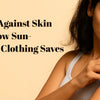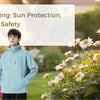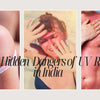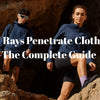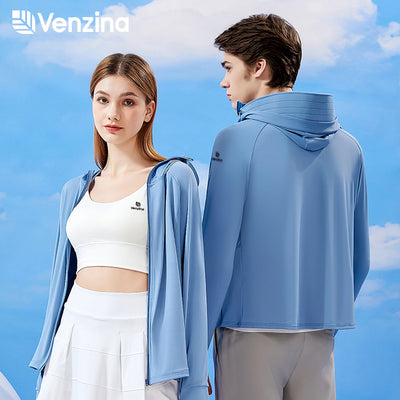Top 7 Alternatives to Sunscreen: What Actually Works
- by IN Venzina

You probably think sunscreen is your only shield against the sun. Actually, most people skip daily sunscreen, and many believe it’s only for the beach or sunny days. Natural options like oils and butters have limits. You can protect yourself with UPF gear, shade, smart habits, or a Sun Protection Jacket.
Key Takeaways
-
UPF 50+ clothing offers the best sun protection, blocking 98% of harmful UV rays without the need for reapplication.
-
Natural ingredients like shea butter and almond oil can moisturize your skin but should not replace sunscreen for UV protection.
-
Combining multiple sun protection methods, such as wearing UPF clothing, seeking shade, and using sunscreen, provides the strongest defense against sun damage.
Natural Sunscreen
Ingredients
When you hear “natural sunscreen,” you probably think of things like plant oils, butters, and minerals. People often use ingredients such as shea butter, coconut oil, almond oil, zinc oxide, and titanium dioxide. Some even try raspberry seed oil or carrot seed oil. These ingredients come from nature and can feel gentle on your skin. You might like them because they are easy to find and simple to use.
-
Shea butter and coconut oil help keep your skin soft.
-
Zinc oxide and titanium dioxide are minerals that can block some UV rays.
-
Plant oils like raspberry seed oil and carrot seed oil have some natural UV-blocking properties.
Coverage
Natural sunscreens can give you some protection from the sun, but they do not work the same way as regular SPF products. You may notice that homemade or natural sunscreens can reduce certain types of skin damage from UV rays. However, they do not prevent sunburn as well as regulated SPF products. Studies show that natural ingredients can help protect your skin’s DNA from UV damage, but they do not match the strength of SPF50+ sunscreen.
Limitations
You can use natural sunscreens as an extra layer of defense. They work best when you combine them with other methods, like wearing UPF clothing or staying in the shade. You should not rely on them alone for full sun protection.
Alternatives Overview
Shea Butter
Shea butter feels rich and creamy on your skin. You might use it to keep your skin soft and smooth. Some people say it helps block a little bit of the sun’s rays. You can use it as a moisturizer before you go outside. Shea butter works best as an extra layer, not as your only sun protection.
Pros:
-
Moisturizes dry skin
-
Easy to find in stores
-
Gentle for most skin types
Cons:
-
Offers very low UV protection
-
Does not replace sunscreen
-
Needs frequent reapplication
Almond Oil
Almond oil feels light and absorbs quickly. You may like it because it has antioxidants that help your skin stay healthy. Almond oil gives you a little bit of UV filtering, but not enough to prevent sunburn. You should not use almond oil alone for sun safety.
Pros:
-
Contains vitamin E
-
Makes skin feel soft
-
Easy to apply
Cons:
-
Very limited UV protection
-
Not a true sunscreen substitute
-
Can make skin oily
Aloe Vera
Aloe vera cools and soothes your skin. You might use it after spending time in the sun. Aloe vera helps repair skin and reduce redness. It does not block UV rays, so you should not use it as your main sun protection.
Pros:
-
Soothes sunburn
-
Hydrates skin
-
Feels refreshing
Cons:
-
No real UV protection
-
Works best after sun exposure
-
Needs to be combined with other methods
Plant Oils
You may hear about plant oils like raspberry seed oil and cranberry seed oil for sun protection. These oils have natural ingredients that help your skin stay healthy. Some people use them as part of their daily routine. Let’s look at how they compare:
|
Oil Type |
Pros |
Cons |
|---|---|---|
|
Raspberry Seed Oil |
Emollient, high in natural tocopherols, UV-A and UV-B absorptive |
N/A |
|
Cranberry Seed Oil |
Moisturizing, unique Omega 6 to Omega 3 ratio, lipid barrier support |
N/A |
Raspberry seed oil absorbs some UV rays and feels nice on your skin. Cranberry seed oil helps keep your skin’s barrier strong. Both oils work best as part of a bigger sun protection plan.
Avocado Oils
Avocado oil feels rich and nourishing. You might use it to help your skin stay soft. Avocado oil has antioxidants and vitamins. It does not give you strong UV protection. You should use avocado oil with other sun safety methods.
Pros:
-
Deeply moisturizes
-
Contains vitamins A, D, and E
-
Good for dry skin
Cons:
-
Low UV protection
-
Can feel heavy
-
Not a sunscreen replacement
DIY Methods
Some people try to make sunscreen at home. You might mix oils, butters, and zinc oxide. DIY sunscreen can feel fun to make, but it is hard to know if it works. Homemade sunscreen may not protect you from sunburn or skin damage.
Pros:
-
Customizable ingredients
-
Can avoid chemicals
-
Fun project
Cons:
-
Hard to test for real protection
-
May not block enough UV rays
-
Risk of under-protection
UPF Clothing
UPF clothing gives you strong and reliable sun protection. You can wear shirts, jackets, hats, arm sleeves, and neck gaiters. UPF 50+ clothing blocks almost all harmful UV rays. You do not need to reapply it, and it works as soon as you put it on.
Here’s how UPF clothing compares to sunscreen:
|
Feature |
UPF Clothing |
Sunscreen |
|---|---|---|
|
Reapplication Requirement |
No need for reapplication |
Requires frequent reapplication |
|
Chemical Content |
Chemical-free |
May contain chemicals |
|
Skin Sensitivity |
Suitable for sensitive skin |
Risk of irritation or allergies |
|
Durability |
Retains properties after washes |
Effectiveness can diminish over time |
|
Cost-effectiveness |
Durable and cost-effective |
May require frequent purchases |
UPF clothing works for all ages and skin types. You can wear it every day, and it keeps you safe without extra effort. If you want the most reliable substitute for sunscreen, UPF clothing is your best choice.
Here’s how UPF clothing compares to sunscreen:
|
Feature |
UPF Clothing |
Sunscreen |
|---|---|---|
|
Reapplication Requirement |
No need for reapplication |
Requires frequent reapplication |
|
Chemical Content |
Chemical-free |
May contain chemicals |
|
Skin Sensitivity |
Suitable for sensitive skin |
Risk of irritation or allergies |
|
Durability |
Retains properties after washes |
Effectiveness can diminish over time |
|
Cost-effectiveness |
Durable and cost-effective |
May require frequent purchases |
UPF clothing works for all ages and skin types. You can wear it every day, and it keeps you safe without extra effort. If you want the most reliable substitute for sunscreen, UPF clothing is your best choice.
Tip: Try a UPF 50+ sun protection jacket or a wide-brim hat for easy, all-day coverage.
UPF Clothing & Accessories
You want sun protection that works all day, no matter what you do outside. UPF 50+ clothing gives you that peace of mind. Lab tests show that UPF 50+ fabric blocks 98% of UVA and UVB rays. You do not need to reapply it, and it keeps working even if you sweat or swim.
UPF 50+ apparel acts like a shield for your skin. You can count on it for reliable sun safety.
Sun Protection Jacket
A Sun Protection Jacket covers your arms, shoulders, and neck. Many jackets come with a hood, so you can protect your ears and the back of your neck. The Venzina UPF 50+ Lightweight Athletic Jacket stands out because it feels light and cool, even on hot days. You get full coverage without feeling weighed down. People love how comfortable it feels and how well it blocks the sun.
Wide-Brim Hats
Wide-brim hats shade your face, ears, and neck. You can wear them with a Sun Protection Jacket for extra coverage. Look for hats with a UPF 50+ rating to make sure you get the best protection.
Arm Sleeves
Arm sleeves slip on easily and protect your arms from the sun. They work well if you wear short sleeves or want to add a layer without getting too hot. You can take them off when you go indoors.
Neck Gaiters
Neck gaiters cover your neck and lower face. You can pull them up for more coverage or wear them loose. They are great for hiking, biking, or any outdoor activity.
-
UPF 50+ clothing pieces that protect your face and body include:
-
Long sleeve hooded shirts
-
Rash guards
-
Sun Protection Jackets
-
Wide-brim hats
-
Arm sleeves
-
Neck gaiters
-
You can mix and match these pieces for full-body sun safety.
UV Accessories
Sunglasses
You might think sunglasses are just a cool fashion choice, but they do much more. Sunglasses protect your eyes from the sun’s harsh rays. If you want the best defense, look for sunglasses labeled UV400. These block 100% of harmful UVA and UVB rays. Regular sunglasses may only filter some UV light, which means your eyes can still get damaged over time.
-
UV400 sunglasses give you complete protection against ultraviolet light.
-
Regular sunglasses might leave your eyes exposed to harmful rays.
-
Choosing UV400 sunglasses helps prevent long-term eye problems.
Sun Umbrellas
A sun umbrella can turn a sunny spot into a safe, shady retreat. You can use one at the beach, park, or even while walking. Not all umbrellas work the same way, so you need to look for a few key features.
-
Pick an umbrella with a UPF rating of 30 or higher for strong UV protection.
-
Bigger umbrellas give you more shade, while smaller ones are easier to carry.
-
Synthetic materials like polyester or nylon block more UV rays than cotton.
-
Darker colors absorb more sunlight, making them better at keeping you safe.
-
Place the umbrella directly overhead and make sure it stays put.
Note: For the best results, combine your sun umbrella with UPF clothing and sunglasses. This way, you cover all your bases and stay protected wherever you go.
With the right UV accessories, you can enjoy the outdoors without worrying about sun damage. Sunglasses and umbrellas make a big difference in your daily sun safety routine.
Shade & Timing

Seeking Shade
You can lower your risk of sunburn by making shade your best friend. When you step outside, look for trees, umbrellas, or canopies. These spots help block direct sunlight and keep you cooler. If you want to create your own shade, grab a portable sunshade or set up a tent. You can also wear protective clothing for extra coverage. Even when you sit in the shade, UV rays can bounce off surfaces like water or concrete. So, it’s smart to use sunscreen as a backup.
Here are some easy ways to seek shade:
-
Stay under trees, umbrellas, or canopies.
-
Use a portable sunshade at the park or beach.
-
Wear UPF clothing for extra protection.
-
Apply sunscreen, even when you’re in the shade.
Outdoor Timing
Timing matters when you want to avoid the strongest sun. UV rays hit hardest between 10 a.m. and 2 p.m. If you plan your outdoor fun before 10 a.m. or after 4 p.m., you dodge the peak hours and lower your risk of sunburn.
|
Time of Day |
UV Intensity |
Recommendation |
|---|---|---|
|
10 a.m. - 2 p.m. |
Peak |
Avoid outdoor activities |
|
Before 10 a.m. |
Lower |
Safe for outdoor activities |
|
After 4 p.m. |
Lower |
Safe for outdoor activities |
You can schedule walks, sports, or picnics in the early morning or late afternoon. This simple change helps keep your skin safe and lets you enjoy the outdoors without worry.
Safety & Effectiveness
Evidence
You might wonder how sunscreen alternatives stack up against traditional SPF products. Let’s break it down. Researchers have compared regular SPF sunscreens with newer options, including nanotechnology-based formulas. Here’s a quick look at how they measure up:
|
Aspect |
Traditional SPF Products |
Nanotechnology-based Sunscreens |
|---|---|---|
|
UV Protection |
Limited |
Enhanced through nanosystems |
|
Cosmetic Appeal |
Often greasy or thick |
Improved texture and feel |
|
Photostability |
Variable |
Higher stability with nanoparticles |
|
Water Resistance |
Limited |
Improved durability |
|
Safety Considerations |
Standard regulations |
Ongoing research on safety |
You see, traditional SPF products follow strict safety rules. They protect your skin from sunburn and long-term damage. Nanotechnology-based sunscreens offer better texture and last longer, but scientists are still studying their safety. Natural alternatives like oils and butters feel nice, but they don’t match the UV protection or durability of regulated SPF formulas.
When to Use SPF
You don’t always need sunscreen for every outdoor moment. Sometimes, UPF clothing and shade do the job. In certain situations, though, you should reach for regulated SPF sunscreen. Here are some times when experts say SPF is a must:
-
You spend time in places with strong sunlight, like Brazil or other high UV regions.
-
You swim, sweat, or play water sports.
-
You travel between countries with different sunscreen standards, such as the US and Europe.
-
You plan to be outside during midday, when the sun is strongest.
Tip: If you’re unsure, add SPF to your routine for extra peace of mind. Your skin will thank you!
Face Protection Without Sunscreen
Sun Protection Jacket
You want to keep your face safe from the sun, but you don’t always want to use sunscreen. A Sun Protection Jacket makes this easy. When you zip up a Sun Protection Jacket, you cover your neck, shoulders, and even part of your face if it has a high collar or hood. This type of jacket blocks UV rays without needing to reapply anything. You can wear it for hours, and it keeps working even if you sweat or play sports. Many people choose a Sun Protection Jacket for hiking, biking, or just walking to school. It’s a simple way to stay protected all day.
Hats & Sunglasses
A wide-brim hat gives your face, ears, and neck shade from the sun. You can pair it with sunglasses to protect your eyes and the skin around them. Sunglasses with UV400 lenses block almost all harmful rays. If you wear both, you lower your risk of sunburn and eye problems. Here’s a quick look at how these methods help:
|
Method |
Description |
|---|---|
|
Seeking Shade |
Stay out of direct sunlight between 10 a.m. and 4 p.m. |
|
Protective Clothing |
Wear long sleeves and pants made from tightly woven fabrics |
|
Wearing Hats |
Use a wide-brim hat to shade your face, ears, and neck |
|
Sunglasses |
Shield your eyes and nearby skin from UV rays |
Physical Coverage
You can use scarves, neck gaiters, or even a mask to cover parts of your face. These items add another layer of protection. If you sweat or get wet, make sure to re-cover your skin with your jacket or accessories. Try to plan outdoor activities for early morning or late afternoon when the sun is less intense. You can also look for shade under trees or umbrellas. When you use these methods together, you build a strong defense against UV rays.
Sun Care Tips
Layering Methods
You want the best protection from the sun, right? Try layering your clothing and accessories. Start with long-sleeved shirts, pants, or skirts. Pick lightweight fabrics like linen or cotton to stay cool. Add a wide-brim hat to shade your face and neck. Slip on UV-protective sunglasses to shield your eyes. Arm sleeves or UV-blocking gloves give extra coverage without making you feel hot. You can adjust your layers if the weather changes. If you play sports or run, a UV-protect running t-shirt and arm sleeves work well. These pieces help you cover up without extra bulk.
Hydration
Did you know that drinking water helps your skin fight sun damage? Hydrated skin stays healthy and strong. It holds moisture better and protects against UV rays. When your skin barrier works well, you lower your risk of sunburn. Keep a water bottle with you and sip often, especially when you’re outside. Your skin will thank you for it!
-
Hydrated skin is better protected against UV exposure.
-
A strong skin barrier helps keep moisture in and harmful rays out.
After-Sun Care
After spending time outdoors, your skin needs some TLC. Dermatologists recommend three simple steps:
|
After-Sun Care Practice |
Benefits |
|---|---|
|
Moisturizing |
Prevents peeling and restores your skin’s barrier. |
|
Soothing |
Reduces irritation, inflammation, and pain from sunburns. |
|
Protecting |
Provides antioxidants like Vitamin E and C to fight environmental stress. |
Use a gentle moisturizer to help your skin recover. Aloe vera gel or creams with Vitamin E and C can calm redness and support healing. If you feel sore or notice redness, apply a soothing lotion right away. Taking care of your skin after sun exposure keeps it healthy and strong for your next adventure.
Best Substitute Verdict
UPF Clothing
If you want the most reliable way to protect your skin from the sun, UPF 50+ clothing is your best bet. You just put it on, and it starts working right away. You do not have to worry about reapplying or missing a spot. UPF clothing covers your skin and blocks both UVA and UVB rays. This means you get strong protection every time you wear it.
Here’s why UPF 50+ clothing stands out:
-
UPF clothing blocks almost all harmful rays, helping prevent skin cancer.
-
People who wear UPF 50+ clothing have 60% fewer new moles than those who wear regular clothes.
-
Outdoor workers in UPF clothing get 40% fewer precancerous skin spots than those who only use sunscreen.
-
A five-year study found a 45% drop in melanoma cases among farm workers who wore UPF clothing every day.
You can trust UPF 50+ clothing for daily sun safety. It works for all ages and skin types. You can wear it for sports, walks, or just running errands.
When to Add SPF
Sometimes, you need even more protection. You should add SPF sunscreen when your skin is exposed or when you spend a lot of time outside. Here’s how you can boost your defense:
-
Use broad-spectrum sunscreen (SPF 30 or higher) on your face, hands, and any skin not covered by clothing.
-
Wear UPF clothing that covers as much skin as possible.
-
Put on a wide-brim hat to shade your face and neck.
-
Wear UV-blocking sunglasses to protect your eyes.
-
Find shade during peak sun hours, from 10 a.m. to 4 p.m.
-
Stay away from tanning beds.
When it comes to sunscreen, we recommend physical sunblock that includes ingredients like zinc oxide or titanium dioxide. These mineral-based ingredients sit on top of the skin and reflect UV rays like a shield. For the best defense against sun damage, combine daily use of physical sunscreen with UPF-rated clothing, and don’t forget to reapply every two hours when you’re outdoors.
With this combo, you get the strongest protection possible—no matter where your day takes you.
Explore UPF Gear
Ready to level up your sun protection? You can do it with the right UPF gear. Venzina offers UPF 50+ hats, jackets, rash guards, and arm sleeves that make sun safety simple and stylish. These pieces work together to keep your skin safe every day.
When you shop for UPF gear, keep an eye out for these important features:
-
UPF Rating: Always choose items with a UPF 50+ label. This rating blocks 98% of harmful UV rays.
-
Fabric Type: Look for tightly woven fabrics like nylon or polyester. These materials hold up well and keep the sun out.
-
Coverage and Design: Pick long sleeves, wide-brim hats, and high collars. The more skin you cover, the better your protection.
-
Durability and Care: Make sure your gear stays protective after washing. Follow the care instructions to keep it working its best.
You can build a reusable protection system with just a few steps:
-
Put on your UPF gear before you head outside. Protection starts the moment you wear it.
-
Add sunscreen to spots your clothes don’t cover, like your ears and hands.
-
Wear your gear during peak sun hours, from 10 a.m. to 4 p.m.
-
Layer up with sun scarves or jackets for extra coverage.
-
Wash your UPF clothing with mild soap to keep it fresh and effective.
Tip: UPF 50+ gear keeps working even if it gets wet or stretched. You get strong, medical-grade protection all day long.
With Venzina’s UPF collection, you can enjoy the outdoors and stay safe—no matter where your adventures take you.
You get the best sun protection by wearing UPF 50+ clothing, seeking shade, and planning your time outside. Check out this table to see how different options stack up:
|
Alternative |
UV Protection Level |
|---|---|
|
UPF 50+ Clothing |
Blocks 98% of UV rays |
|
Zinc Oxide |
Broad-spectrum |
|
Titanium Dioxide |
Broad-spectrum |
UPF clothing gives you built-in protection, so you don’t have to keep reapplying sunscreen. For long days outdoors, add SPF 30 or higher to any exposed skin. Stay safe and enjoy the sun!
FAQ
What is a natural sunscreen, and how does it differ from SPF products?
Natural sunscreen uses plant oils or minerals. SPF products go through strict testing. You get more reliable protection from SPF products.
Tip: Use natural sunscreen as an extra layer, not your only defense.
Can almond oil or shea butter work as a true sunscreen substitute?
No, almond oil and shea butter do not block enough UV rays. You should not use them alone for sun safety.
-
Use them for moisture.
-
Always add real sun protection.
Which UPF features matter most when choosing a sunscreen alternative?
Look for UPF 50+ rating, tight fabric weave, and full coverage. These features give you the best sun protection.
|
Feature |
Why It Matters |
|---|---|
|
UPF 50+ |
Blocks 98% of UV rays |
|
Tightly Woven |
Less sunlight gets in |
|
Full Coverage |
More skin stays safe |

